
Rio Grande do Sul is a state in the southern region of Brazil. It is the fifth-most populous state and the ninth-largest by area. Located in the southernmost part of the country, Rio Grande do Sul is bordered clockwise by Santa Catarina to the north and northeast, the Atlantic Ocean to the east, the Uruguayan departments of Rocha, Treinta y Tres, Cerro Largo, Rivera, and Artigas to the south and southwest, and the Argentine provinces of Corrientes and Misiones to the west and northwest. The capital and largest city is Porto Alegre. The state has the highest life expectancy in Brazil, and the crime rate is relatively low compared to the Brazilian national average. Despite the high standard of living, unemployment is still high in the state, as of 2017. The state has 5.4% of the Brazilian population and it is responsible for 6.6% of the Brazilian GDP.
Talian, or Brazilian Venetian, is a Venetian dialect spoken primarily in the Serra Gaúcha region in the northeast of the state of Rio Grande do Sul in Brazil. It is also spoken in other parts of Rio Grande do Sul, as well as in parts of Espírito Santo and of Santa Catarina.
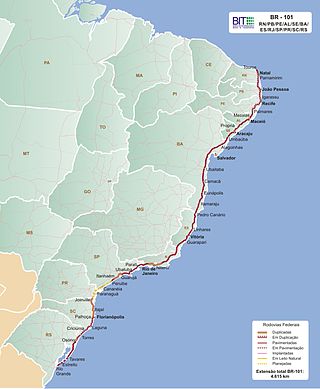
The BR-101 is a longitudinal highway of Brazil. It is the longest in the country with a length of nearly 4,800 km (3,000 mi), and it is considered one of the most important highways in the country, along with BR-116.
The German-based varieties spoken by German Brazilians together form a significant minority language in Brazil. "Brazilian German" is strongly influenced by Portuguese and to a lesser extent by Italian dialects as well as indigenous languages. High German and Low Saxon/German dialects and Germanic languages are particularly strong in Brazil's South and Southeast Regions. According to Ethnologue, ca. 3 million people in Brazil speak the Hunsrik Language, 1.5 million speak Standard German.

Santa Maria is a municipality (município) in the central region of Rio Grande do Sul, the southernmost state of Brazil. In 2020, its population was 283,677 inhabitants in a total area of 1,823 square kilometres (704 sq mi). Santa Maria is the 5th biggest municipality in the state, and the largest in its micro-region.
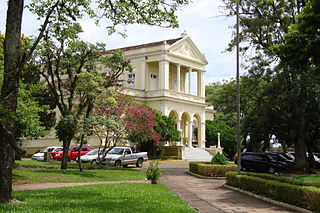
Santa Cruz do Sul is a city in central Rio Grande do Sul, Brazil. The city has an estimate 131,000 inhabitants as of 2020 and sits about 150 km from the capital city of the state, Porto Alegre. The city enjoys a high standard of living and gross income per capita is 2.5 times greater than that of the state of Rio Grande do Sul as a whole.
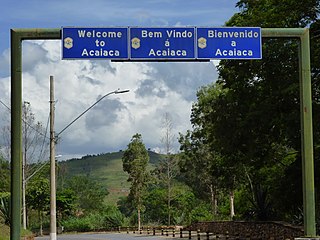
Portuguese is the official and national language of Brazil being widely spoken by most of the population. Brazil is the most populous Portuguese-speaking country in the world, with its lands comprising the majority of Portugal's former colonial holdings in the Americas.

Tourism is a growing sector and key to the economy of several regions of Brazil. The country had 6.589 million visitors in 2018, ranking in terms of the international tourist arrivals as the second main destination in South America after Argentina and third in Latin America after Mexico and Argentina. Revenues from international tourists reached US$5.8 billion in 2015, continuing a recovery trend from the 2008–2009 economic crisis.

The South Is My Country is a separatist movement that seeks the independence of Brazil's South Region, formed by the states of Paraná, Rio Grande do Sul, and Santa Catarina. The group claims the region is under-represented by Brasília.
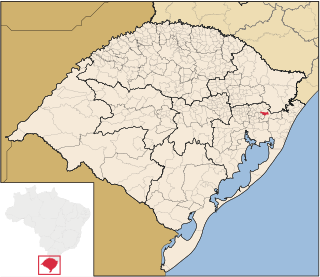
Igrejinha is a municipality located in the metropolitan area of Porto Alegre, in the state of Rio Grande do Sul, Brazil. Home to the Morro Alto da Pedra and the regional park Parque Alto da Pedra. The city has approximately 37,000 inhabitants and sits about 82 km from the capital city of the state, Porto Alegre.

Futebol Clube Santa Cruz is a Brazilian football club from Santa Cruz do Sul, Rio Grande do Sul, founded on March 26, 1913. It plays in the Campeonato Gaúcho. Its rival is Esporte Clube Avenida.

Zero Hora is a Brazilian newspaper based in the city of Porto Alegre, the sixth biggest of the country. It is edited by Grupo RBS.
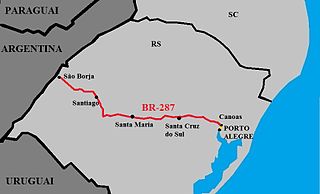
The BR-287 is a 536.9 km-long federal highway across the Brazilian state of Rio Grande do Sul, also known as the Highway of Integration.

Aldyr Garcia Schlee was a Brazilian writer, journalist, translator, illustrator, and professor.
The 2016 Copa do Nordeste was the 14th edition of the main football tournament featuring teams from the Brazilian Northeast Region. The competition featured 20 clubs, with Bahia and Pernambuco having three seeds each, and Ceará, Rio Grande do Norte, Sergipe, Alagoas, Paraíba, Maranhão and Piauí with two seeds each. Santa Cruz (Pernambuco) qualified to play in the 2016 Copa Sudamericana, after winning the final against Campinense (Paraíba) 3–2 on aggregate.
Santa Cruz also qualified to play in the 2017 Copa Sudamericana but CONMEBOL reduced the Brazilian berths from 8 to 6. Therefore, the champions Santa Cruz and Paysandu lost their Copa Sudamericana berths. Finally, they qualified for the 2017 Copa do Brasil Round of 16.
Ceará were the defending champion, but were eliminated by Santa Cruz in the quarterfinals.

Miss Brazil 2018, officially Miss Brazil Be Emotion 2018, was the 64th edition of the Miss Brazil pageant. It was held on 26 May 2018 at Riocentro in Rio de Janeiro, and was hosted by Cássio Reis and Maria Eugênia Suconic. Monalysa Alcântara of Piauí crowned her successor Mayra Dias of Amazonas at the end of the event. Dias represented Brazil at the Miss Universe 2018 pageant and placed Top 20.
The following is a timeline of the history of the city of Porto Alegre, in the state of Rio Grande do Sul, Brazil.

Miss Rio Grande do Sul is a Brazilian Beauty pageant which selects the representative for the State of Rio Grande do Sul at the Miss Brazil contest. The pageant was created in 1954 and has been held every year since with the exception of 1990, 1993, and 2020. The pageant is held annually with representation of several municipalities. Since 2023, Bebeto Azevêdo has been the state director of Miss Rio Grande do Sul. Rio Grande do Sul is the state with the most crowns in the national contest and also the state that produced the first Miss Brazil to win the Miss Universe contest, Iêda Maria Vargas of Porto Alegre.

Events in the year 2023 in Brazil.
















